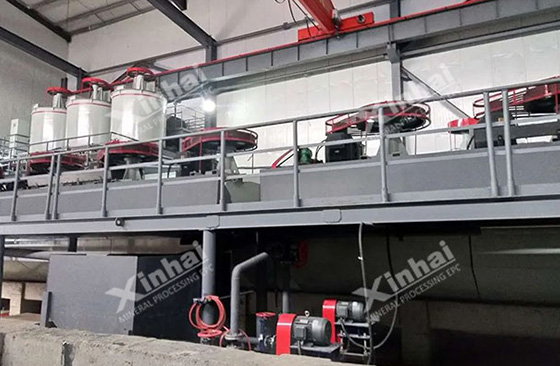Fine-grained hematite is mainly composed of iron oxides, with particles usually smaller than 0.02 mm. It is an important iron ore. At the same time, it is an important industrial raw material with a wide range of applications in industry. It is an important raw material for manufacturing steel and other iron products and is used in construction, automobile manufacturing, machinery manufacturing, shipbuilding and other fields. In practical production, there are many beneficiation process methods for fine-grained hematite, including total flotation, strong magnetic separation-flotation, roasting magnetic separation-reverse flotation and other processes. In order to improve the separation efficiency of fine-grained hematite, attention should be paid to the selection of selective and efficient grinding technology, ultra-fine grinding technology, strong magnetic separation technology, fine-grained flotation technology and high-efficiency flotation reagents in terms of mineral processing technology. The following will introduce you to the beneficiation process methods of fine-grained hematite and the attention to beneficiation technology.
Use the table of contents below to navigate through the guide:
01Beneficiation process methods for fine-grained hematite
1. Full flotation process of hematite: adding fatty acid anion collector during flotation, and sodium carbonate is used as the pH adjuster of the slurry, which can effectively solve the problems of high viscosity of the slurry and difficulty in dehydrating the concentrate. The two-stage concentration operation during the concentration stage can effectively reduce the loss of metal minerals.

(Iron ore flotation)
2. Strong magnetic separation-flotation process: After the coarse grinding process, gangue minerals such as single quartz and easily muddy chlorite in the ore can be eliminated through the strong magnetic separation process to obtain qualified concentrate, which is the next step. Fine grinding and flotation create favorable conditions.
3. Roasting-magnetic separation process: Hematite ore is roasted in a shaft furnace and heated and reduced with a mixture of coke oven and blast furnace gas to produce artificial magnetite. The obtained ore is subjected to magnetic separation to obtain iron concentrate products.
4. Roasting magnetic separation-reverse flotation process: After the above-mentioned roasting magnetic separation, the iron concentrate is obtained. In order to further improve the quality of the concentrate, reverse flotation can be performed. During flotation, dodecaamine cationic collector is added to the slurry and reverse flotation is performed in a neutral medium.
5. Strong magnetic separation process: When processing iron oxide quartzite, the use of strong magnetic separation process can reduce energy consumption and increase the recovery rate of concentrate. Therefore, the magnetic separation process is one of the important processing methods for iron oxide quartzite.

(Iron ore magnetic separation)
6. Stage grinding, gravity magnetic-anion reverse flotation process: using high-efficiency and low-consumption pulsating high-gradient strong magnetic separator, it can effectively improve the grade of the concentrate while ensuring the metal recovery rate and the production capacity of the iron ore production line. , reduce the cost of chemicals generated by mineral processing.
7. Forward flotation and selective flocculation, desliming and reverse flotation methods: Preliminary desliming operation is required before forward flotation, and then Thar oil is used as a collector in a neutral medium, which can make the concentrate filtration more efficient. easy. During selective flocculation, desliming and reverse flotation, the ore is finely ground, screened and classified in a circuit composed of grinding equipment, vibrating screens and hydrocyclones, and corn starch is added to the overflow slurry as an iron mineral. Inhibitors.
02What should we pay attention to when beneficiating fine-grained hematite?
In order to reduce the development cost of fine-grained hematite, minerals should be recovered as early as possible during mineral processing to improve production efficiency and save costs. In addition to paying attention to more crushing and less grinding and stage grinding and separation, we also need to pay attention to several aspects:

(iron ore grinding)
1. Selective and efficient grinding technology: When processing fine-grained hematite, insufficient grinding and over-grinding are coexisting problems. Therefore, targeted grinding and timely classification of already ground qualified ore are key to reducing over-grinding and improving mineral processing efficiency. The use of selective grinding can improve the dissociation degree of useful mineral monomers, while also reducing the phenomenon of over-crushing to optimize the mineral composition of the selected materials, thereby improving the concentrate grade and recovery rate.
2. Ultra-fine grinding technology: When the required grinding fineness is small, using an ordinary ball mill to process the ore will not only fail to obtain the ideal particle size, but will also increase grinding consumption. Therefore, when processing fine-grained lean hematite, other grinding equipment can be selected, such as vertical stirred mills.
3. Strong magnetic separation technology: Strong magnetic separation equipment is one of the important equipment for recovering hematite. However, when strong magnetic separation equipment is used to recover fine-grained hematite ore with a particle size of 30 microns, it will cause serious losses of useful minerals. . In order to solve this problem, the concentrator can use a combined wet strong magnetic separator to recover hematite ore.

(Iron ore flotation)
4. Fine particle flotation technology and high-efficiency flotation reagents: The flotation method is an important separation method for iron oxide ore. Among them, the weak magnetic separation-strong magnetic separation-anion reverse flotation process is commonly used in iron ore flotation. method. This process uses sodium hydroxide, caustic starch, lime and fatty acid collectors as the flotation agent system.
The above contents are matters needing attention in the selection of fine-grained hematite beneficiation and beneficiation technology. A reasonable beneficiation method should be formulated based on the characteristics of the ore and the requirements of the produced products. Xinhai Mining recommends conducting a beneficiation test to determine the composition of the ore, formulating a reasonable hematite beneficiation method and configuring the beneficiation equipment, thereby improving the iron ore taste and recovery rate.


 marketing@ytxinhai.com
marketing@ytxinhai.com  0086 13810327080
0086 13810327080 






































































































 CHAT
CHAT MESSAGE
MESSAGE






